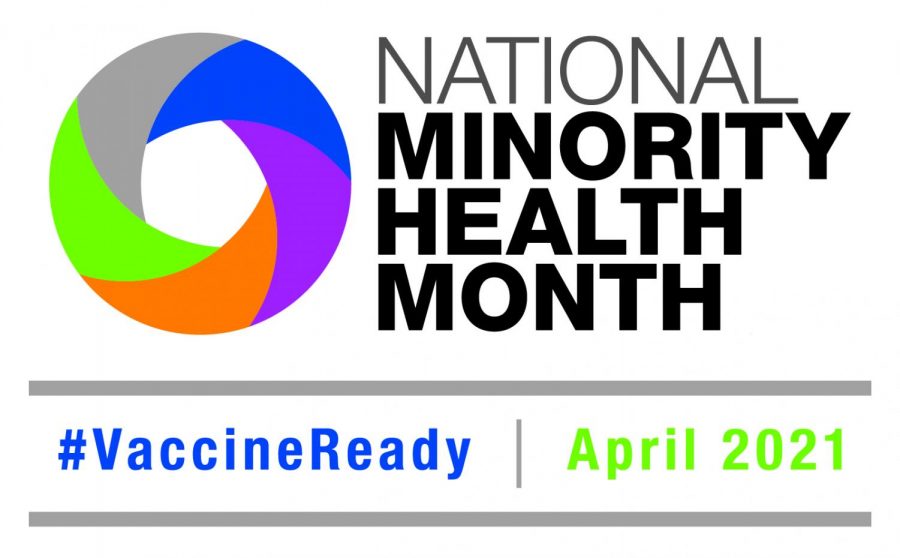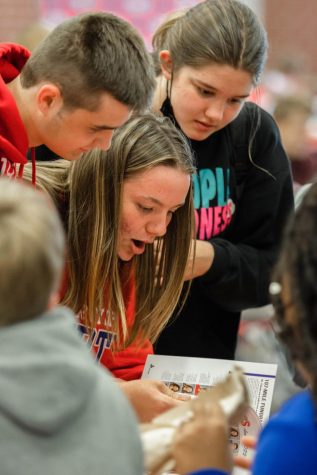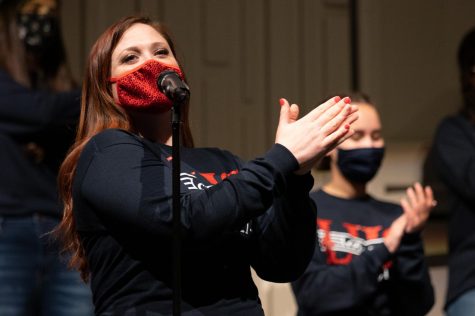Office of Minority Health Strives To Reduce Disparities In Healthcare
Led by the community, for the community
May 17, 2021
courtesy of U.S. Department of Health and Human Services
April was National Minority Health Month, and the National Office of Minority Health spent it improving coronavirus vaccine distribution to minorities.
Over the past year, the coronavirus has exposed cracks in the spackled walls of the United States’ healthcare system. More information is being spread about itemized bills and the unequal treatment different people receive, but these are problems that have complicated the lives of millions of Americans for decades. In Missouri, there is an advisory committee within the Office of Minority Health, Missouri Department of Health and Senior Services in charge of dealing with that.
“The main objective of the Regional Minority Health Alliance is to improve the health outcomes in the different regions,” Chief of the Office of Minority Health Joseph Palm said. “And what it takes to make that happen varies from area to area, because what happens in Springfield is different than what happens in St. Louis, or Moberly, or Columbia or just the city, you see certain issues that are similar in those areas, but the ways that you go about achieving better health outcomes is different.”
The Office of Minority Health was established by the Missouri General Assembly in August 1988. Chapter 192 within the Public Health and Welfare section of the Revised Statutes states, “The office of minority health shall monitor the progress of all programs in the department for their impact on eliminating the health status disparity between minorities and the general population.” Since then, the Alliance has fought to provide more resources to all Missourians, but they’ve placed a heavy emphasis on the issues that have been setting minorities back for decades.
The Kaiser Family Foundation, linked on the Department of Health and Senior Services’ data site, collects statistics on disparities in healthcare by state. Their data shows that 26.8% of people who don’t have medical coverage are minorities, despite the fact that 82% of Missouri’s population is white.
These issues might not be apparent on the surface, but they are always bubbling up just underneath. Whether it be costs, racial bias, hospital errors, medical fraud, lack of insurance, or access to care, there are roadblocks that disproportionately affect minorities in Missouri. However, Palm believes that all of these are derived from the same major issue: communication, or lack thereof. He explained his mindset for when he approaches these types of problems.
Conflict Resolution via GIS Mapping
“If you look at it, the homicide rates are off the track. So I get why some people say, ‘Well, what are you going to do about blacks killing blacks?’ I get that,” Palm said. “I would go and look at the data and say, ‘Okay, what were the circumstances of this homicide?’ I do not know if you noticed, but 80% of homicides result from an argument. I actually researched that because I just don’t look at surface-level stuff. If you see that 80% of homicides result from an argument, then you have to look at that argument. And one answer to the problem is conflict resolution. If I was trying to prevent homicide, I would deal with, ‘How do I teach conflict resolution to the community?’”
A technique that Palm also employs is geospatial mapping, or GIS (Geographic Information System) mapping. He starts by taking a map and dividing it into different areas. After that, he does what he calls the overlays, which is layering more maps atop the original map. He’ll mark the schools that are achieving versus the ones that aren’t on the map, then look at the factors affecting their scores: Where are the grocery stores located? Where are the liquor stores located? Where are the hospitals located?
“What you’re going to do is, you’re going to take all that information, you’re going to put it in our system — because, guess what?” Palm said. “You may see, wow, for 20 years, homicides have been happening right here, and for 20 years, it’s been a corner grocery store, and for 20 years, people have not had access to this.”
Different areas have different priorities even when you look at improving health outcomes. It’s a very complex system. You have to be out there and really stay on top of what’s going on.
— Joseph Palm
These may not directly correlate with the healthcare system, but disparities in healthcare are only one problem that arises from a lack of engagement with the community. The Office of Minority Health is the only office dedicated to this in state government, which makes the job that much more strenuous.
“Different areas have different priorities even when you look at improving health outcomes. It’s a very complex system. You have to be out there and really stay on top of what’s going on. And you have to have relationships and build those relationships and build trust within a community, and show that you care about the community, you care about minorities, you care about the outcomes and that you’re there to help and not necessarily perform some study on the community and publish the paper, or fulfill some requirements where you just go in and do a study after receiving major grant funding and you’re not necessarily concerned about making a sustainable effort in the community,” Palm said.
Community Beginnings
This fervor to improve circumstances for minorities comes from a personal place for the chief.
“I’ve been in this position for 12 years,” Palm said. “However, I’ve been working in the community since I was 9 years old. My grandmother, God rest her soul, she passed away 18 years ago. But my grandmother was a domestic house cleaner. She had her own business. She cleaned homes for a lot of wealthy whites in the St. Louis region. As a child, I would go with her to help her clean and it exposed me to a different side, even though, of course, after we were done cleaning that house, we came back home to poverty. I’m somebody that can relate to anyone in poverty, because back then we had roaches, mice, and rats in that house. There used to be a time where they gave out government cheese and different types of food, and I grew up receiving free and reduced lunch.”
Some people face these realities on a daily basis. But the dilemma isn’t only in the situation: it’s in all the factors making it up. It matters whether or not there’s a good hospital nearby; it matters whether or not the local school has the funding its students need. The healthcare system may bear poison fruit, but its problems begin at the roots.
“This is not a job where you can — I mean, you could get appointed to this job. But if you don’t have real experience in the community, you will be unsuccessful,” Palm said. “What really got me in public health was when I realized the poor health conditions, and how they affected my grandmother, and affected my great-grandma, and affected my mother, and affected my father. It was really traumatic to know that, wow, this could have been different had there been health education and awareness in my family.”
There could be an organic grocery store providing healthy food and a good hospital with hard-working doctors in a community, but as long as they don’t reach out to the people they serve, the community can’t take advantage of those resources.
“It’s like someone learning how to read and may have had books all around them. But if you don’t know how to read, you just have books all around you,” Palm said. “I grew up down the block from St. Luke’s Hospital. The most I knew about St. Luke’s Hospital was that they had a nice gift store and they had candy stripers. And other than that St. Luke’s didn’t reach out to the community. In fact, they left the community and they moved.”
And you have to have relationships and build those relationships and build trust within a community, and show that you care about the community, you care about minorities, you care about the outcomes and that you’re there to help and not necessarily perform some study on the community and publish the paper, or fulfill some requirements where you just go in and do a study after receiving major grant funding and you’re not necessarily concerned about making a sustainable effort in the community.
— Joseph Palm
Someone else noticed the space and potential the hospital left behind — Maxine Clark, who is best known for founding Build-a-Bear Workshop, but recently kickstarted a project to mend the Delmar Divide. It refers to Delmar Boulevard, a socioeconomic and racial division in St. Louis. Clark left the Workshop in 2013 to work on improving public education. After helping open a KIPP school in St. Louis, she noticed an empty building where a St. Luke’s Hospital used to be, and it gave her the idea to create the $100 million project known as the Delmar Divine. According to their website, the Divine’s objective is to “maximize the efficiency, effectiveness, and impact of the nonprofit sector in the St. Louis region, especially among health, education and human service organizations, while simultaneously being a catalyst for the transformation of nearby neighborhoods.”
Perception Plays a Role
These projects and buildings are only as good as the effort they put into communicating with their community. Palm has dedicated his career to building bridges for minorities, but his work has been exacerbated by everyday racism and colorism.
“Now let me tell you my handicap, and I’m gonna be honest with you. My handicap is how black males are perceived, in many cases,” Palm said. “If Director Randall [of the Department of Health and Senior Services] and I are in the same room, people gravitate to Director Randall, and they’ll ask him, ‘Well, what, what can I do?’ And he’ll say, ‘Joe is the chief of Minority Health and he can help you with this.’ They’ll say, ‘Well you’re the decision maker.’ They’ll just disregard me, right? And Director Randall will tell them, ‘Well, no, Joe, is the person you should talk to, that’s what you need to deal with.’ If Director Randall’s not there, it’s hard for me to get the conversation going. So I have to fight to help people, because I have to get them to overcome the fact that I’m a dark-skinned black male.”
For the Office of Minority Health, minority welfare goes beyond the doctor’s waiting room. There are everyday conversations that need to be had, but often, people aren’t willing to surrender their prejudices long enough to hear them out. Palm has found that once that initial hurdle is past, then the real change begins.
“Once I can get people to overcome that fact and make them feel comfortable, then you know what people say to me? They say, ‘No, I didn’t know you could do that. Why didn’t you tell me you could do all of that?’ And, actually, I have told them. It’s just that we have to change perception.”
When trying to start conversations with an opposing political side, he urges against language that could antagonize people.
“I don’t ever really talk about racism, because racism is a very divisive word, and you have to really be careful,” Palm said. “I wouldn’t use the word racism. I would say fairness. And I would say that if I have a high school education, and you have a high school education, and this job is not looking at your GPA coming out of high school, how is it that you have this many jobs, and you have this many high school graduates? And this percentage of them is white, and this percentage of them is black, and both have applied, how is it that it just ended up being 90% white and 10% black? I mean, what do you attribute that to? And I feel like I just would like to hear people explain that to me. Usually, when I bring up issues, I just deal with numbers.”
He argued that staying on the side of logic, abiding by numbers, opens more doors and builds stronger relationships. He gave an example and mentioned a friend in Parma, Missouri who purchased new boxing equipment for a North St. Louis Gym.
Minorities disproportionately report poor mental health and problems with smoking, asthma, and obesity. The problem becomes even more evident with access to medical care: minorities make up 87.4% of adults who haven’t seen a doctor in the past 12 months for financial reasons, and 80.3% of adults who don’t have a personal doctor or healthcare provider. Numbers like these help expose those cracks — but filling them in is going to take patience and, as the chief puts it, honey.
“If you are antagonistic, if you don’t know someone in a rural area, and you just come to them and say, ‘You know what, you’re racist.’ Well, I’m gonna be honest with you, if somebody comes into your house and tells you, ‘Hey, you know, what, you got a problem. And you need to do this and do that,’ you’re not going to take that very well,” Palm said. “There is an old saying in the country, that you catch more flies with honey.”
He also clarified that the Office doesn’t only help minorities. If they find a struggling community, they work to fix the problem the community is suffering from.
“When you see certain areas that have poor health outcomes, there’s all different races of people that live there. So we don’t go down there to help and then say, ‘Well, hold on. You’re white, we can’t help you,’” Palm said. “But I can also tell you on the other side, I think that success would look like if we didn’t need the Office of Minority Health.”
“[Director Randall]’s from North Carolina, and him and I, we have some real deep talks. Sometimes I have to tell him stuff three or four times before he gets what I’m saying, but it is what it is,” Palm said. “So, you know, needless to say, communication is key.”
These inequalities in healthcare aren’t new, and the chief is right — the raison d’être of the Office of Minority Health is for Missouri to not need an Office of Minority Health. If the statistics are to be believed, that won’t happen in this generation, but if change begets change, it could happen in the next one, or the one after. That kind of time will create more gaps, and the only way to work against it is by talking to each other. That’s not to say it’ll be easy, but if you’re looking for hope that it can be done, look no further than Palm’s stories and the Office’s toils.





